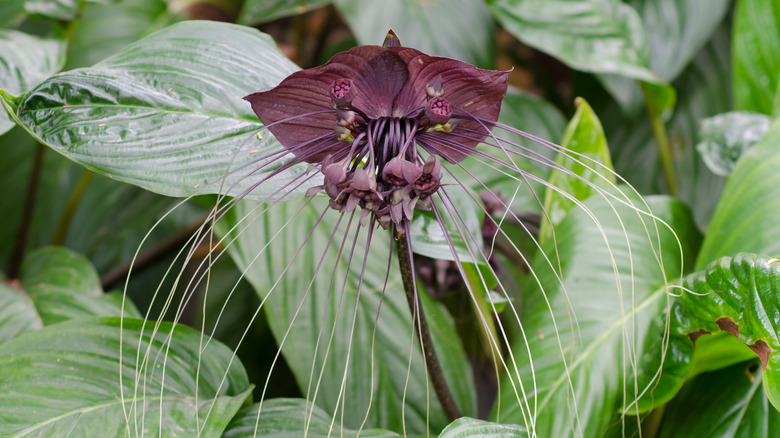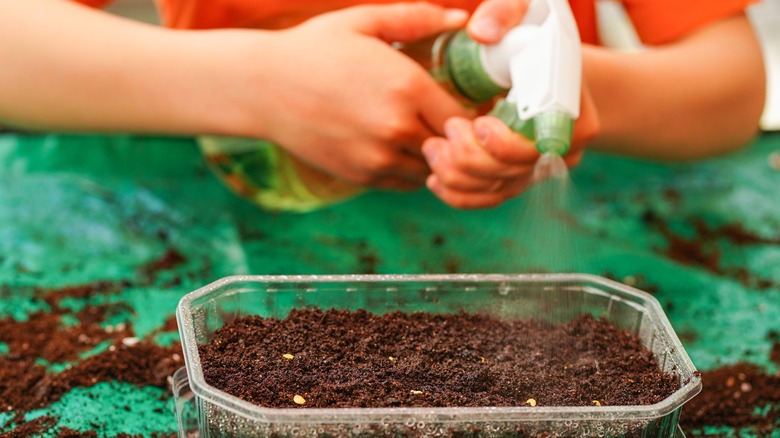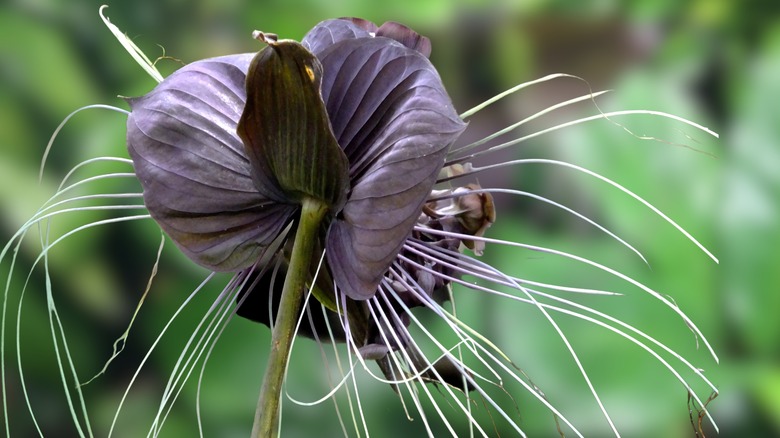The Bat Flower Is A Rare Bloom That Is Worth The Extra Effort To Grow
If you like a gardening challenge and want to expand your plant collection with a truly unique species, look no further than the black bat flower (Tacca chantrieri). This native of Southeast Asia will bewitch you with its mysterious, one-of-a-kind black inflorescences. These feature tiny individual flowers, black bracts that tower over them like the wings of a bat, and long, drooping bracteoles. The point of this elaborate configuration is the subject of speculation — botanists can't reach a consensus as to why it looks the way it does. Regardless of their evolutionary purpose, the bat flower's fascinating looks have earned the plant several other monikers. For example, Tacca chantrieri also goes by "the Devil's herb" due to its sinister appearance, or "cat's whiskers" on account of its lengthy bracteoles.
But despite the spooky names, the bat flower is a gentle (and rather fragile) charmer. Getting this plant to reveal its majestic black blooms is no easy feat when grown out of its native, humid tropical habitat. Even seed germination can take several months. That said, if you're patient and do your best to meet the environmental needs of this rare beauty, your efforts may pay off. With the right conditions, you may be able to grow and keep black bat flowers healthy for years to come.
How to plant black bat flowers successfully
To successfully grow the black bat flower and keep it happy, you'll have to recreate its natural environment as best you can. Unless you're in southern Florida or Hawaii — the nation's only tropical climate zones — you'll need to grow this flower as an indoor or greenhouse plant. You may have luck finding black bat flowers at a local nursery, but given the rarity of the species, you may need to grow it from seeds like these sold on Smart Seeds Emporium. Be aware that seed age affects germination time. Newly collected seeds germinate in under three months, while older seeds can take more than half a year. Ask the shop or online retailer how old the seeds are so you have a rough idea of how long it might take for the seedlings to emerge.
Before you plant the bat flower seeds, keep them in warm water for a full day. While the seeds soak, you can prepare a suitable potting mix. The substrate should be well-draining and include peat moss, pumice or perlite, and vermiculite. After the 24-hour soaking period, you can place the seeds right below the surface of the soil. Cover the pot with saran wrap or foil. Place the pot in a bright location where radiant heat from the sun's rays can keep the soil and air warm and humid. As you wait for the plants to germinate, keep the soil moist by misting it regularly.
How to maintain a suitable environment for black bat flowers
As the Tacca chantrieri plants grow and mature, you will have to maintain a muggy environment for them. If you live in a zone where summers are hot and humid, you can leave the potted plants outdoors for the duration of the warm season. Just take care not to place them in direct sunlight — the black bat flowers do their best in full or partial shade. When the cold returns, bring the plants in and overwinter them indoors. The ideal location for overwintering Tacca chantrieri is any part of the house where indirect light is abundant but it can remain safely out of full sun. Whether the plants are indoors or out in your yard, water them regularly — and evenly — to keep the soil from drying out. Even with all their adoration for moisture and humidity, proper soil drainage is important as soggy soil leaves black bat flower rhizomes susceptible to rot.
Once you have established your black bat flower plants, propagating them is easy. Come spring, check if the pots are getting too tight for the plants. If they are, you can dig the plants up and split their rhizomes with a sharp blade before repotting — this should encourage healthy plant growth. Your black bat plants will flourish for many years with proper care, and the only pest you need to worry about is the mealybug. But you can banish mealybugs from your garden using common kitchen ingredients.


